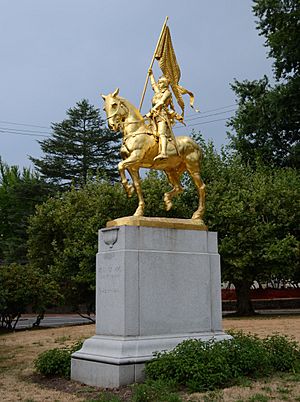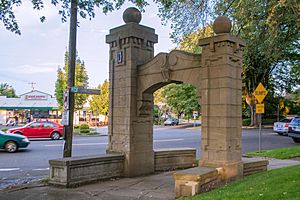Laurelhurst, Portland, Oregon facts for kids
Quick facts for kids
Laurelhurst
|
|
|---|---|
|
Neighborhood
|
|

The equestrian statue of Joan of Arc in Coe Circle, Laurelhurst
|
|
| Country | United States |
| State | Oregon |
| City | Portland |
| Area | |
| • Total | 0.67 sq mi (1.73 km2) |
| Population
(2000)
|
|
| • Total | 4,549 |
| • Density | 6,810/sq mi (2,629/km2) |
| Housing | |
| • No. of households | 1,765 |
| • Occupancy rate | 97% occupied |
| • Owner-occupied | 1,615 households (92%) |
| • Renting | 150 households (8%) |
Laurelhurst is a charming neighborhood in Portland, Oregon. It's known for its old, beautiful homes and winding streets. The neighborhood surrounds a lovely green space called Laurelhurst Park. You can spot stone markers at the entrances to the area. At the very center, in Coe Circle, stands a golden statue of Joan of Arc. This statue is a special World War I memorial. In 2019, the Laurelhurst Historic District was officially added to the National Register of Historic Places.
Contents
History of Laurelhurst
In 1909, a large piece of land called Hazelfern Farm was sold to the Laurelhurst Company. This company paid about $2 million for the 462-acre (1.87 km2) farm. The name "Laurelhurst" came from another neighborhood Paul Murphy had developed in Seattle. It combined "laurel" (a type of shrub) with "hurst," an Old English word for a wooded hill.
The Laurelhurst Company planned a new neighborhood with 144 acres (0.58 km2) of homes. They worked with a landscape architect named John Charles Olmsted. As the first houses were being built, the city bought 31 acres (130,000 m2) of land. This land became Laurelhurst Park, costing the city $92,000.
Rules for the New Neighborhood
The Laurelhurst Company advertised the area as a "High Class Residence Park." They set many rules for the neighborhood. For example, selling alcohol was not allowed. Also, there could be no apartments, hotels, or commercial buildings.
Sadly, some of these rules were unfair and discriminatory. They stated that homes could not be sold to Chinese, Japanese, or African American people. These rules were part of a "racial covenant" from 1913. This meant that people of certain races were prevented from living there. This was a common practice in the past that created unfair housing situations.
In 1934, a "redlining" map of Portland marked Laurelhurst as "Still Desirable." These maps were used to guide lending and development. The map noted that the area had a "homogenous" (meaning very similar) population. It also reported no foreign-born or Black residents. These practices show how neighborhoods were shaped by unfair rules long ago.
Community and Transportation
In the 1970s, the Laurelhurst Neighborhood Association (LNA) discussed big changes for Portland's transportation. This led to the creation of Trimet MAX Light Rail in the 1980s. The LNA and the community supported light rail in one area, but not another. They did not want it along the Burnside corridor.
In 1978, many neighbors signed a petition. They did not want any parking, widening, or lane changes on East Burnside Street. They felt these changes would harm their neighborhood. They believed it would lower property values and disrupt their daily lives. A city study agreed that projects should be minimized in the Laurelhurst area.
Neighborhood Life Today
The Laurelhurst Neighborhood Association works to keep the community a great place to live. They focus on making sure parks and areas near schools are safe and clean for children. They also discuss new building projects in the neighborhood. Sometimes, they have concerns about increasing the number of homes available.


